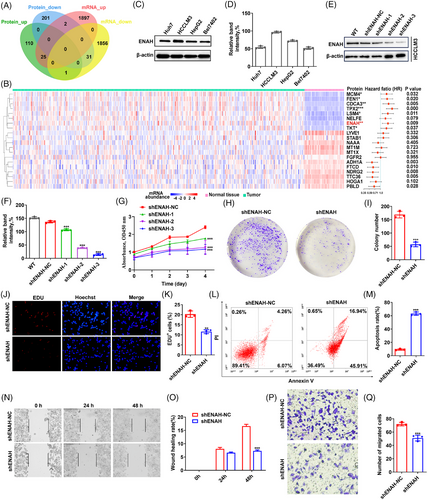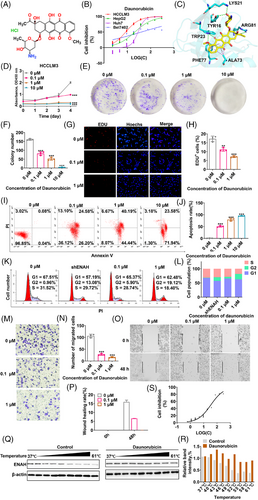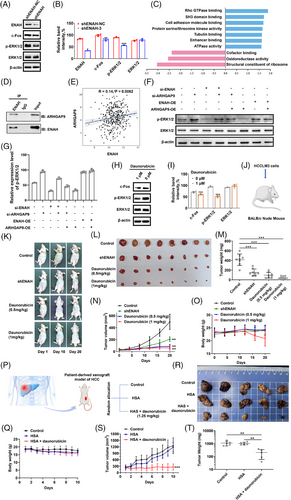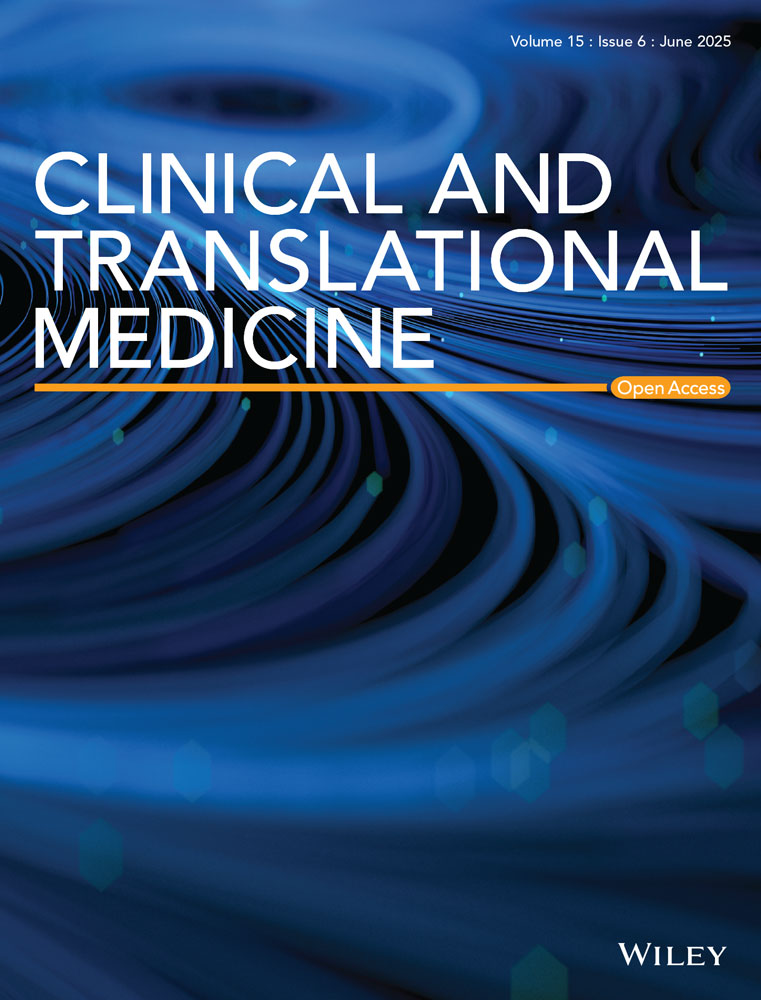Targeting enabled homolog with daunorubicin inhibits ERK1/2/c-Fos pathway and suppresses hepatocellular carcinoma progression
Dear Editor
The enabled/vasodilator stimulated phosphoprotein family (Ena/VASP) of actin regulatory proteins are critical players in maintenance of cell shape, motility, regulation of molecular interactions, and contribute to hepatocellular carcinoma (HCC) development,1 rendering them ideal candidate targets for therapy, whereas understanding their regulatory mechanisms remains an unmet challenge and no sufficiently potent compounds to interfere with Ena/VASP in HCC have been reported.2, 3 In this context, we identified enabled homolog (ENAH), a member of Ena/VASP, as a promising target for pharmaceutical intervention derived from multi-omics analysis. Using biochemical and molecular biology assays, for the first time we report daunorubicin, a known drug used to treat acute myeloid leukaemia, as an ENAH inhibitor. This study aims to uncover the underlying mechanism and investigate the therapeutic potential of daunorubicin in preclinical HCC models.
We collected resected primary tumour samples and normal paired adjacent tissues (NATs) from 20 early-stage HCC patients without radiotherapy or prior chemotherapy (Table S1). Four pairs of qualified samples were selected for proteomic and transcriptomic analyses. Using isobaric standard mass tag labelling, 371 differentially expressed proteins (DEPs) were identified in tumours compared to NATs (Figure S1A and C and Table S2). mRNA sequencing (mRNA-seq) profiled 24 381 genes, among which 1888 and 1924 protein-coding genes were significantly down- and upregulated, respectively, in HCCs (Figure S1B and D and Table S3). DEPs featured biological activities of metabolic processes, focal adhesion, and actin binding function. Compared with proteomic data, mRNA-seq profile additionally exhibited functional enrichment with GTPase activity, MAPK cascade, ERK1/ERK2, and other signalling pathways in HCC (Figure S1E–H and Table S4).
Among 3812 dysregulated protein-coding genes, 56 showed concordances between mRNA and protein abundance (Figure 1A). Signatures specific to the amino acid metabolic process and ERK1/2 regulation were significantly enriched in the tumours (Figure S2A). In particular, novel molecules such as ENAH, HOGA1, and FGFR2, were related to focal adhesion, cytoskeleton organisation, and actin filament process, which are implicated in tumourigenesis and metastasis. Using correlation analysis, 32 proteins were identified as representative signatures associated with HCC (Figure S2B), of which 20 were significantly dysregulated in TCGA dataset (Figure S2C). Among them (highlighted in Figure 1B), seven molecules, especially TPX2, CDCA3, and ENAH, displayed very high risk scores for the mortality prognosis of HCC. Here, we focused on ENAH, which exhibited upregulated mRNA levels associated with higher stage/pathological grade/poor clinical prognosis of patients and has been reported to be a critical effector mediating cellular cytoskeletal motility related to tumour development4 (Figure S2D–G, Tables S5 and S6). IHC staining confirmed ENAH overexpression in HCC and its usefulness as a feature marker (Figure S2H and I and Table S7). In addition, ENAH showed higher abundance in most tumours, such as lung adenocarcinoma and cholangiocarcinoma, than in normal tissues (Figure S2J). The Human Pathology Atlas data indicated that elevated ENAH levels were also significantly correlated with overall survival (OS) in urothelial cancer, renal cancer, and breast cancer.

To confirm the role of ENAH in HCC progression, we knocked down ENAH in HCCLM3 cells that exhibited the highest expression level of ENAH compared to other human HCC cell lines (Figure 1C–F). We found that ENAH knockdown suppressed cell proliferation, migration and triggered their apoptosis (Figure 1G–Q). Thus, therapies targeting ENAH, such as small molecules, may be beneficial for HCC treatment.
Novel ENAH inhibitors were screened from an in-house library comprising 2040 compounds using structure-based virtual ligand screening. Fourteen compounds with prominent docking CDOCKER energies capable of binding ENAH were selected for further investigation (Figures 2A and S3A and Table S8). Four HCC cell lines (HCCLM3, HepG2, Huh7 and Bel7402) with different ENAH expression levels were selected as test models (Figure 1C). As shown in Figure 2B and Table S9, dose-response curves demonstrated a progressive sensitivity to compound 11: Bel7402 (low ENAH, IC50 = 41.20 ± 1.61 µM), Huh7 (intermediate ENAH, IC50 = 28.93 ± 1.46 µM), HepG2 (intermediate ENAH, IC50 = 21.15 ± 1.36 µM) and HCCLM3 (high ENAH, IC50 = 7.42 ± 0.06 µM). The sensitivity was correlated with ENAH expression levels in the four cells, indicating that compound 11 (daunorubicin) induced an ENAH-dependent cancer cell death. The docking models of daunorubicin-ENAH complexes revealed key interactions, including hydrogen bonds with TRP23, π-π stacking with PHE77, and hydrogen bonds with TYR16, LYS21, ARG81 and ALA73 (Figures 2C and S3B–D). In vitro evaluations of daunorubicin showed dose-dependent inhibition of cell proliferation, apoptosis, migration, and cell cycle analyses showed that daunorubicin increased G2 arrest, and similar effects were observed in ENAH knockdown cells (Figure 2D–P). The interaction between ENAH and daunorubicin was confirmed by the cellular thermal shift assay (CETSA) (Figure 2Q and R). More importantly, ENAH knockdown decreased the inhibitory effect of daunorubicin on cell proliferation (IC50 = 34.60 ± 1.83 µM) (Figure 2S). These findings provide powerful evidence that daunorubicin directly interacts with ENAH and inhibits malignant phenotypes of HCCLM3 cells.

The ERK1/2/c-Fos pathway has been described as a linchpin tumourigenic mechanism associated with HCC.5 Nevertheless, its diversity and cryptic pharmacologic accessibility pose challenges, new efforts are underway to exploit unrecognised vulnerabilities for novel targeted therapies. Activated p-ERK1/2/c-Fos overexpression has been reported to be required for G2 arrest.6 Based on previous studies, as expected, ENAH knockdown reduced p-ERK/c-Fos expression (Figure 3A and B), and induced G2 arrest (Figure 2K), indicating that ENAH, positioned upstream of the oncogene ERK1/2, can be a new way to regulate this signalling pathway. Bioinformatics analyses showed that 11 839 genes were significantly correlated with ENAH expression, SH3 domain binding, Rho GTPase binding, and cell adhesion molecule binding among the most markedly enriched functions (Figures 3C and S4A and B). ENAH contains the Ena/VASP homology domains EVH1, EVH2, and the central proline-rich region that interacts with the SH3 and WW domains.7 Using SMART tool, we identified Rho GTPase activating proteins (Rho GAPs) with combinations of SH3 and WW domains, including ARHGAP9, ARHGAP12, and ARHGAP27, as potential ENAH interactors. Co-IP results suggested that ENAH directly binds to ARHGAP9 (Figure 3D), which inactivates Rho GTPases and plays a pivotal role in cell cytoskeleton organisation, migration, proliferation, and cancer formation. Specifically, Rho GTPases display ERK-activating functions8 (Figure S4C). Using bioinformatics analysis, ARHGAP9, which interacted with ENAH, was predicted to affect ERK1/2 signalling networks (Figures 3E and S4D). Comprehensive functional experiments confirmed the critical role of ENAH-ARHGAP9 interaction in ERK1/2 modulation (Figure 3F and G). Collectively, we reason the mechanism of ENAH as an oncogenic protein capable of activating the ERK1/2/c-Fos pathway by interacting with ARHGAP9 in HCC cells. The responsiveness of HCCLM3 cells to daunorubicin was attributed to its ability to bind to ENAH and suppress the ERK1/2/c-Fos signalling pathway (Figure 3H and I).

In vivo studies showed that both ENAH knockdown and daunorubicin treatment resulted in a favourable tumour regression in HCCLM3 CDX model (Figure 3J–O). PDX model with high ENAH amplification also showed marked tumour reduction upon daunorubicin treatment and no significant signs of weight loss at 1.25 mg/kg (Figure 3P–T).
In conclusion, this report highlights ENAH as a drug-targetable protein identified through multi-omics analyses, and uncovers a novel role in regulating ERK1/2/c-Fos activity. Meanwhile, our results demonstrate that daunorubicin can directly target ENAH and serve as a powerful ENAH inhibitor for HCCLM3 treatment. Notably, our study delineates the multi-omics landscape and molecular features that drive the HCC phenotypes, enabling a deeper understanding of the mechanisms underlying HCC progression and providing an exemplary demonstration for further precision-targeted medicine research.
AUTHOR CONTRIBUTIONS
Ming-Gao Zhao, Wei-Ming You and Zhi-Mei Li conceived the project, designed the experiments, and wrote the paper. Zhi-Mei Li performed the proteomics, transcriptomic, and bioinformatics analysis. Qing-Qing Liu performed the molecular docking experiments. Zhi-Mei Li and Guan Liu performed the pharmacological experiments. All authors critically revised the content and approved the final version for submission.
ACKNOWLEDGEMENTS
The authors would like to thank the patients who participated in this study and the staff at Tangdu Hospital for their help collecting HCC samples.
FUNDING
This work was supported by the Natural Science Foundation of Shaanxi Province 2022JQ-815.
CONFLICT OF INTEREST STATEMENT
The authors declare no conflicts of interest.
ETHICS STATEMENT
The HCC tissues and NAT samples used in this study were obtained from the Tangdu Hospital of Air Force Military Medical University with the approval of the Research Ethics Committee of the hospital. Written informed consent was obtained from all patients. All experimental and animal care protocols were approved by the Laboratory Animal Center of the Northwestern Polytechnical University and the Ethics Committee.
Open Research
DATA AVAILABILITY STATEMENT
All data needed to evaluate the conclusions in the paper are present in the paper and/or the Supplementary Material. Additional data related to this paper may be requested from the authors.




